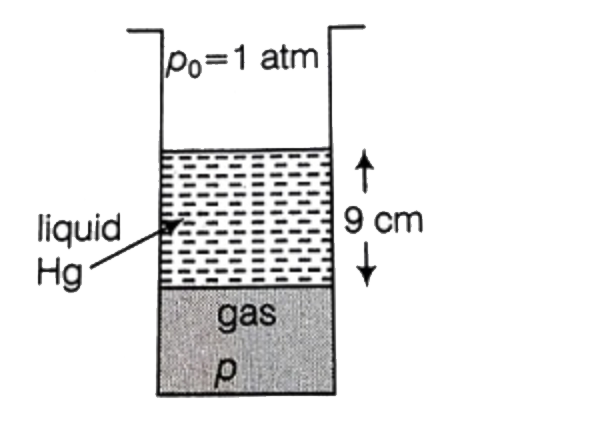The heights of mercury surfaces in the two arms of the manometer shown in figure are 2 cm and 8cm. Atmospheric pressure =1.01×105Nm−2 . Find (a). the pressure of the gas in the cylinder and (b). the pressure of mercury at the bottom of the U tube.

The correct Answer is:A, B
a. Given h1=8cm
h2=2cm
ρHg=13.6gm
ρa=1.01×105Nm2
=1.01×105×10dy≠cm2
Pressure at the bottom of the tube shold be same when considered for both limbs from the ure are shown.
→Pg+ρHg×h2×g
=Pa+ρHg×h1×g
−.Pg=P0+ρHg×g(h1−h2)
=1.01×105+13.6×980
×(8−2)dy≠cm2
=(1.01×106+13.6×980×6)Dy≠cm2
=1.09×105Nm2
b. m=45kg(Fromtheureshown)<br>P^3+hpg=P_q+(mg)/A<brrarr hpg=(mg)/A<br><imga≤ocr_imageload∈g=lazysrc=https://d10lpgp6xz60nq.cloudfront.net/physics_images/HCV_VOL1_C13_E01_047_S01.pngwh=80%mx-autosty≤=background:white;><br>rarr h=m/(Ap)<br>= 45/(900xx10^-4xx10^3)<br>=0.5m=50cm
Topper's Solved these Questions
Similar Questions
The heights of mercury surfaces in the tow arms of the manometer shown in figure are 2 cm and 8cm. Atmospheric pressure =1.01×105Nm−2 . Find
a) the pressure of the gas in the cylinder
b) the pressure of mercury at the bottom of the U tube.

View SolutionThe manometer has a water column difference of 50 cm . If the atmospheric pressure is 105 Pa, find the pressure of the gas in the container .
View SolutionThe height of mercury barometer is h when the atmospheic pressure is 105Pa. The pressure at x in the shown diagram is

View SolutionWhat is the pressure on a swimmer 10m below the surface of lake? g=10ms−2, atmospheric pressure = 1.01×105Pa
View SolutionWhat is the absolute pressure on a swimmer 10m below the surface of a lake? Take atmospheric pressure 1×105N/m2
View SolutionA manometer reads the pressure of a gas in a enclosure as shown in figure(a) When some of the gas is removed by a pump, the manometer reads as in (b). The liquid used in the manometers is mercury and the atmospheric pressure is 76cm of mercury.

(i) Give the absolute and gauge pressure of the gas in the enclosure for cases (a) and (b) in units of cm of mercury .
(ii) How would the level change in case (b) if 13.6cm of water are poured into the right limb of the manometer?
View SolutionA manometer reads the pressure of a gas in a enclosure as shown in figure(a) When some of the gas is removed by a pump, the manometer reads as in (b). The liquid used in the manometers is mercury and the atmospheric pressure is 76cm of mercury.

(i) Give the absolute and gauge pressure of the gas in the enclosure for cases (a) and (b) in units of cm of mercury .
(ii) How would the level change in case (b) if 13.6cm of water are poured into the right limb of the manometer?
View SolutionIn a constant volume gas thermometer, the pressure of the working gas is measured by the difference in the levels of mercury in the two arms of a U-tube connected to the gas at one end. When the bulb is placed at the room temperature 27.00C, the mercury column in the arm open to atmosphere stands 5.00cm above the level of mercury in the other arm. When the bulb is placed in a hot liquid, the difference of mercury levels becomes 45.0cm. Calculate the temperature of the liquid. (Atmospheric pressure =75.0cm of mercury).
View SolutionIn a constant volume gas thermometer, the pressure of the working gas is measured by the differenced in the levels of mercury in the two arms of a U-tube connected to the gas at one end. When the bulb is placed at the room temperature 27.00C, the mercury column in the arm open to atmosphere stands 5.00cm above the level of mercury in the other arm. When the bulb is placed in a hot liquid, the difference of mercury levels becomes 45..0Cm. Calculate the temperature of the liquid. (Atmospheric pressure =75.0cm of mercury).
View SolutionIn the given figure, atmospheric pressure p0=1 atm and mercury column length is 9 cm. Pressure p of the gas enclosed in the tube is

View Solution
